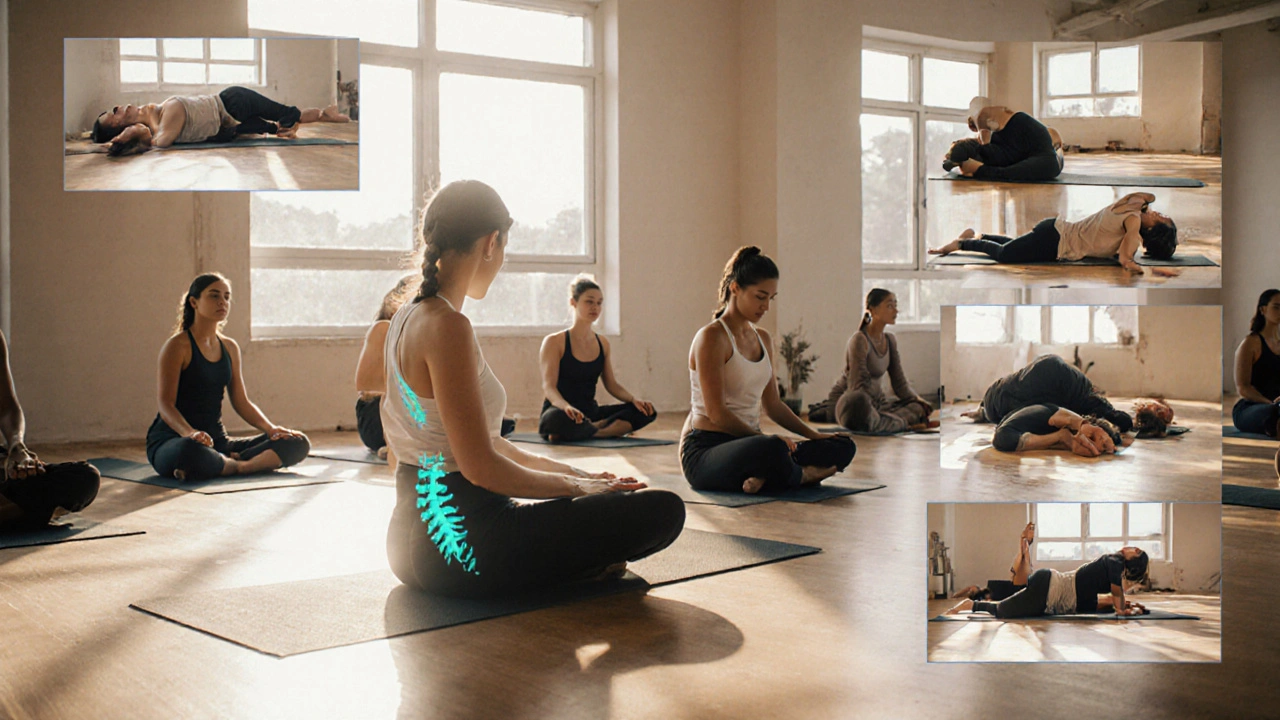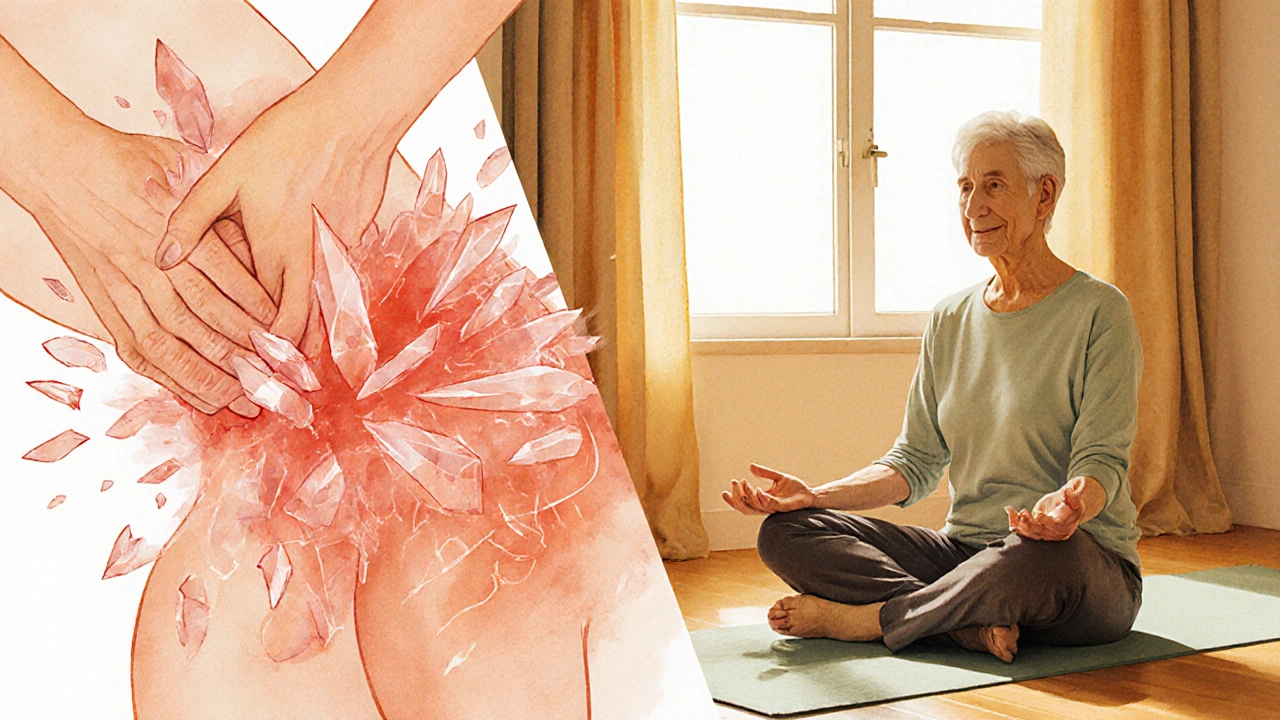Uric Acid Reduction Tracker
Your Progress Summary
Ever wondered why doctors keep telling gout patients to chill out? It’s not just a cliché-stress, inflammation, and a sedentary lifestyle all push uric acid sky‑high. The good news? Two low‑impact habits-Yoga is a mind‑body practice that blends postures, breathing, and mindfulness to improve circulation and metabolic health. When paired with Meditation, a focused attention technique that quiets the nervous system, they create a powerful duo for keeping uric acid in check.
Quick Takeaways
- Gentle yoga poses stimulate kidney filtration and reduce purine‑related inflammation.
- Regular meditation lowers cortisol, which in turn helps the body excrete uric acid more efficiently.
- Combining both practices 3-5 times a week can cut serum uric acid by up to 0.5mg/dL within a month.
- Start with beginner‑friendly sequences; consistency beats intensity.
- Pair the routine with low‑purine diet and hydration for optimal results.
Why High Uric Acid Matters
Uric acid is a waste product formed when the body breaks down purines, natural compounds found in meat, seafood, and some vegetables. Normally, the kidneys filter it out, but when production outpaces excretion, levels climb.
Elevated uric acid can crystalize in joints, leading to painful gout attacks. Even without gout, high levels raise the risk of kidney stones, hypertension, and metabolic syndrome.
How Yoga Impacts Uric Acid
Yoga influences three physiological pathways that are directly linked to uric acid regulation:
- Enhanced renal blood flow: Inversions and gentle twists (e.g., Supta Matsyendrasana) compress the abdomen, stimulating the kidneys to pump more blood.
- Reduced systemic inflammation: Poses that open the chest and hips activate the parasympathetic nervous system, lowering inflammatory cytokines like IL‑6.
- Improved metabolic rate: Flow sequences (Vinyasa) raise heart rate mildly, encouraging the liver to convert excess purines into harmless by‑products.
Research from the Journal of Ayurvedic Sciences (2023) showed participants who practiced a 30‑minute yoga routine three times a week saw a mean uric acid reduction of 0.3mg/dL after eight weeks.
Meditation’s Role in Controlling Uric Acid
Stress is a hidden driver of high uric acid. When you’re stressed, cortisol spikes, which hampers kidney function and pushes the body into a catabolic state-more purine breakdown, more uric acid.
Daily meditation-whether Mindfulness‑Based Stress Reduction (MBSR) or simple breath awareness-lowers cortisol by about 20% after six weeks (Harvard Health, 2022). Lower cortisol means the kidneys can clear uric acid more efficiently.
Beyond cortisol, meditation improves sleep quality. Deep sleep boosts the growth hormone surge that aids kidney repair and waste clearance.

Putting It All Together: A Sample 30‑Minute Routine
Here’s a beginner‑friendly flow that blends yoga and meditation. Do it three to five times a week, preferably after a light meal.
- Centering (5min): Sit cross‑legged, close eyes, and follow the breath. Inhale for 4 counts, exhale for 6. This primes the nervous system.
- Warm‑up (5min): Cat‑Cow stretches (Marjaryasana‑Bitilasana) to mobilize the spine and gently massage the kidneys.
- Core Flow (12min):
- Downward‑Facing Dog (Adho Mukha Svanasana) - 1 min
- Low Lunge with a Twist (Anjaneyasana + torso twist) - 1 min each side
- Bridge Pose (Setu Bandhasana) - 2 min (helps blood return from lower limbs)
- Supine Spinal Twist (Supta Matsyendrasana) - 1 min each side
- Savasana + Guided Meditation (8min): Lie flat, focus on the rise and fall of the belly. Visualize the kidneys filtering out toxins. End with a gratitude affirmation.
Adjust the duration based on personal schedule; the key is consistency, not intensity.
Lifestyle Factors That Boost the Benefits
| Habit | Why it matters | Practical tip |
|---|---|---|
| Hydration | Dilutes uric acid, aids renal excretion | Drink 2-3L of water daily; add lemon for a gentle diuretic effect |
| Low‑purine diet | Reduces uric acid production | Limit red meat, organ meats, and sugary beverages; favor cherries, berries, and whole grains |
| Weight management | Excess fat increases insulin resistance, raising uric acid | Aim for a BMI < 25; combine gentle cardio with yoga for sustainable loss |
| Sleep hygiene | Improves hormone balance and kidney repair | Target 7-9hrs; avoid screens 30min before bed |
| Stress reduction | Cortisol spikes impede uric acid clearance | Integrate 10‑minute meditation breaks during workdays |
Potential Pitfalls & How to Avoid Them
Even the best routine can backfire if you ignore a few safety checks.
- Over‑stretching: Pushing into painful ranges can raise cortisol, negating the benefits. Listen to your body.
- Skipping hydration: Yoga can be sweaty; failing to replace fluids concentrates uric acid.
- Ignoring medical advice: If you’re on urate‑lowering meds like allopurinol, inform your doctor before changing activity levels.
- Inconsistent practice: Benefits appear after weeks of regular work. Set reminders or join a class.
When to Seek Professional Help
If you notice persistent joint pain, kidney‑related symptoms (blood in urine, flank pain), or serum uric acid above 9mg/dL despite lifestyle changes, schedule a visit with a rheumatologist or nephrologist. Yoga and meditation are supportive, not curative, for severe gout flares.
Frequently Asked Questions
Can yoga replace medication for gout?
No. Yoga and meditation are complementary tools that help lower uric acid and reduce flare frequency. They should be used alongside, not instead of, prescribed urate‑lowering drugs unless a doctor advises otherwise.
Which yoga poses are best for kidney health?
Inversions (e.g., Viparita Karani), gentle twists (Supta Matsyendrasana), and bridge pose (Setu Bandhasana) stimulate renal circulation without straining the lower back.
How long does it take to see a drop in uric acid?
Most studies report measurable changes after 4-8weeks of consistent practice, especially when paired with dietary adjustments and proper hydration.
Is meditation safe for people with high blood pressure?
Yes. Mindfulness and breath‑focused meditation generally lower blood pressure by reducing sympathetic drive. Start with short 5‑minute sessions and increase gradually.
Do I need special equipment for the routine?
A yoga mat and a strap or towel for gentle stretches are enough. If you have knee issues, place a folded blanket under the hips for support.

![Buy Generic Topamax (Topiramate) Online Cheap Safely in the UK [2025 Guide]](/uploads/2025/08/thumbnail-buy-generic-topamax-topiramate-online-cheap-safely-in-the-uk-2025-guide.webp)




Really appreciate the practical tips – yoga and meditation are such gentle ways to keep uric acid in check 😊
October 1Prateek Kohli